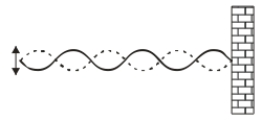 A standing wave is created by oscillating a taut string at a frequency that corresponds to one of the resonant frequencies. The amplitude of the antinodes is very much larger than the amplitude of the oscillator. Does this violate the conservation of energy principle? Explain why.
A standing wave is created by oscillating a taut string at a frequency that corresponds to one of the resonant frequencies. The amplitude of the antinodes is very much larger than the amplitude of the oscillator. Does this violate the conservation of energy principle? Explain why.
A) Yes, since E is proportional to amplitude squared.
B) Yes, since there is large kinetic energy of the string, and this is much bigger than the energy from the oscillator.
C) No, energy from waves does not obey the conservation of energy principle in the first place.
D) No, the energy at the antinodes builds up after the first few cycles, after which the dissipation due to friction equals the energy supplied by the oscillator.
E) Whether it obeys the conservation of energy principle depends on the tension in the string.
Correct Answer:
Verified

